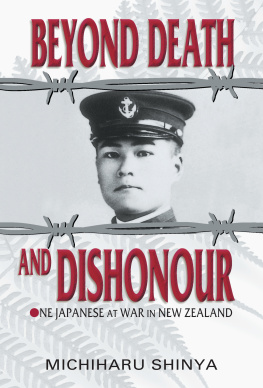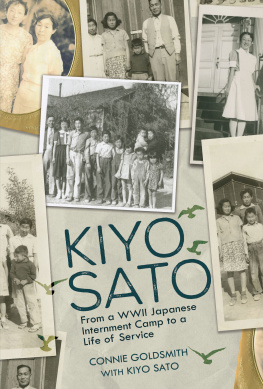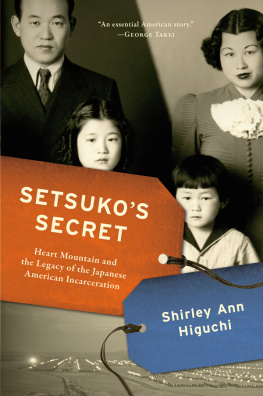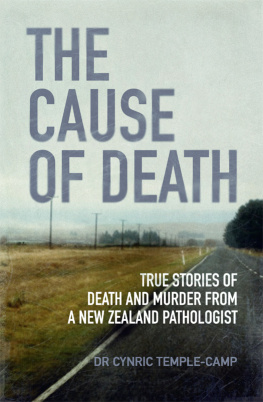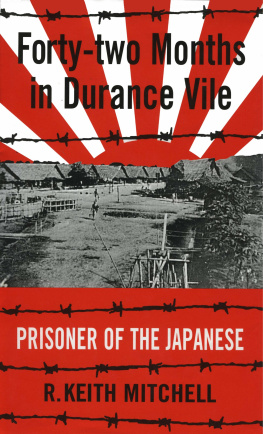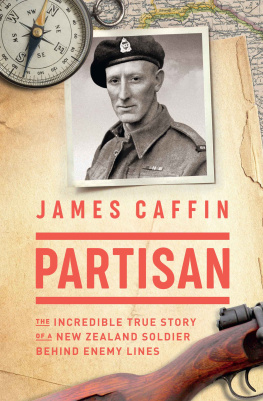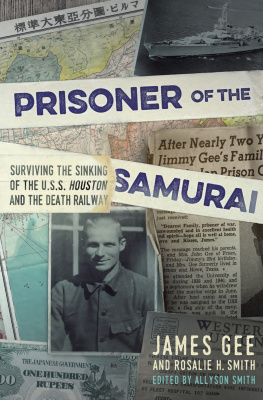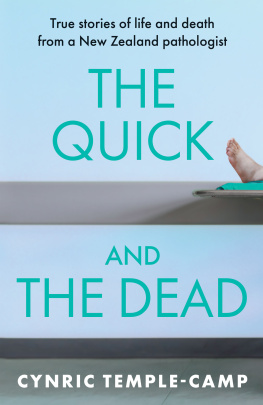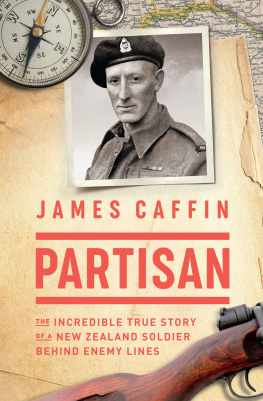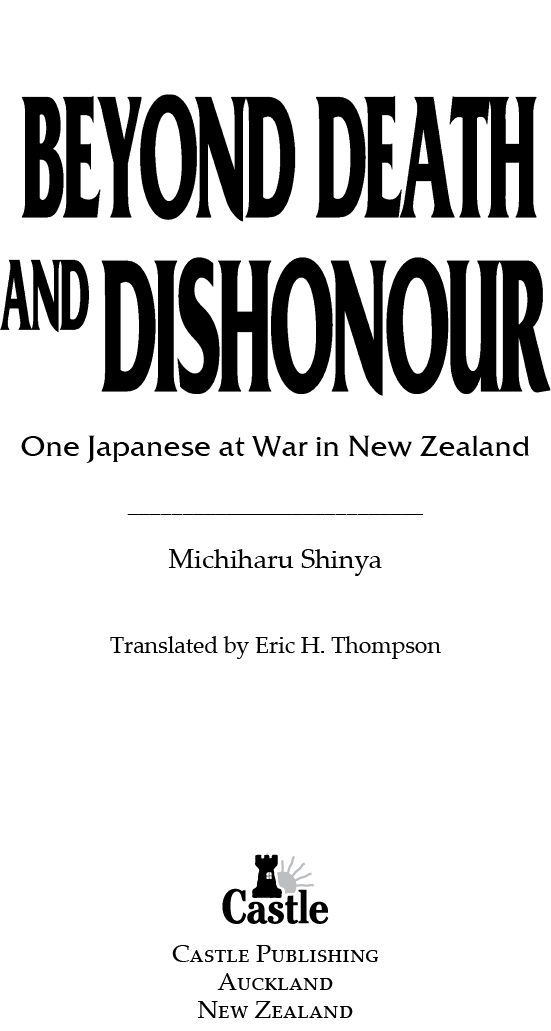
Beyond Death and Dishonour
Published by Castle Publishing Ltd
PO Box 12577, Penrose
Auckland 1642, New Zealand
www.castlepublishing.co.nz
2001 & 2018 Michiharu Shinya
ISBN 978-0-9582124-6-5 (Softcover)
ISBN 978-0-9876682-9-5 (ePUB)
ISBN 978-0-9876598-0-4 (Kindle)
Originally published as The Path from Guadalcanal
by Outrigger Publishers, Auckland, New Zealand
1979, Original translation from Japanese by Eric Hardisty Thompson
1988, Published in Japan by Seibunsha Publishing as From the Sea of Death to the Pulpit
Text revised for this edition by Kay Wall
Editor: Vivienne Hill
Production: Andrew Killick
Cover design by Jeff Hagan
Scripture taken from the
HOLY BIBLE, NEW INTERNATIONAL VERSION . Copyright 1973, 1978, 1984 International Bible Society. Used by permission of International Bible Society. NIV and New International Version are trademarks registered in the United States Patent and Trademark office by International Bible Society.
ALL RIGHTS RESERVED
No part of this publication may be reproduced, stored in a retrieval system, or transmitted, in any form or by any means, electronic, mechanical, photocopying, recording, or otherwise, without prior written permission.
Cover photo: Michiharu Shinya (1937) (courtesy of the author)
I dedicate this book to the people of New Zealand with my deep thanks.
Michiharu Shinya
Out of the depths I cry to you, O Lord.
Psalm 130:1
Acknowledgements
I wish to extend my deepest thanks to all those involved in this project, in particular my friend Eric H Thompson who originally translated this book, and who sadly passed away in 2000 . I would also like to thank Kay Wall for her revision of the book, the staff of Castle Publishing in New Zealand for producing this new edition, all those who encouraged me to write my story, and OMF International for their support.
Thanks to Robert and Alison Smith, Warren and Doreen Payne, and Capt. Nigel Luscombe for their advice and input on aspects of the text. Thanks to Stewart Hillman for proofreading and encouragement.
Thanks to Noel Earles, and the Alexander Turnbull Library, National Library of New Zealand, Te Puna Matauranga o Aotearoa for kindly allowing us to use their photographs.
Lastly I would like to thank my wife and family, and God who saved me in my darkest hour.
Guadalcanal
Guadalcanal loomed to starboard, close and ominous through the pervading blackness. Moment by moment we were pressing closer to enemy territory. On the Japanese destroyer Akatsuki s darkened bridge nerves were taut and all were concentrated on lookout.
It was just past midnight, 13 November 1942. I was a naval lieutenant, serving as torpedo officer on the destroyer Akatsuki an escort for the Guadalcanal Volunteer Force. I gave the preliminary orders to prepare our torpedoes and stood at the starboard firing control position, ready to launch. Would the enemy fleet be ready and waiting? Yesterday an American B-17 reconnaissance plane had spotted us. Our fighters had failed to destroy it so it seemed our hopes of a surprise attack fled with the pilot.
Our commander in chief, Yamamoto, had established his headquarters at Truk, the linchpin of Japans naval defence, to better control operations. Truk provided a perfect staging base to support Rabaul, 1500 kms south. Ships based at Rabaul could strike quickly at any point in the Solomons or New Guinea. From our air bases there, we could bomb targets as distant as Darwin, Australia.
The strategy adopted from Truk was to use a battleship squadron to gain mastery of the Guadalcanal airfield. It was vital that we expelled the Americans and controlled our airfield again. Whoever controlled the airfield controlled Guadalcanal. In turn, whoever controlled Guadalcanal controlled the Solomon Islands, a chain approximately 800 kms long. The American occupation threatened our air bases at Rabaul and thus was a menace to all Japanese operations in the area.
The battleships of the Eleventh Squadron, Hiei and Kirishima , under Vice Admiral Hiroaki Abe, would pound the enemy at the airfield with their 36 cm main guns at midnight, 12 November. With a shortage of destroyers at Truk, Akatsuki was chosen to be one of the escorts for the battleship squadron. The main strength of the Second Fleet, commanded by Vice Admiral Nobutake Kondo, together with the aircraft carrier Junyo would provide support.
If the enemy were alerted, our advance destroyer division would forewarn us. Our hearing strained to pick up the slightest crackle from the radiotelephone, but no interruption came.
The Americans were at last recovering from the rout of Pearl Harbour and had inflicted their first real counter-attack with their bold landing on the island on the 7 August. Japanese construction units had completed the airfield and our planes were about to occupy the base when it was snatched away, leaving us looking like a man whos had his fried bean curd stolen by a scavenging hawk.
Critical battles were fought in and around Guadalcanal in the Solomon Islands over six months from August 1942. Some 30,000 Japanese died in these campaigns. American deaths were fewer but for all participants, Guadalcanal became known as a hellhole of jungle warfare and tropical disease.
Land-based air power was superior to sea-based air power. An enemy fleet operating in a zone controlled by friendly land-based bombers, risked huge losses. Japanese occupation of the Solomons could provide a springboard for further operations against the supply line between the United States and Australia. Supplies allowed one to make war and kept armies alive. Armies without supplies faced the jungle alone and, in the South Pacific, the jungle killed. Therefore the Americans had to be ejected.
We felt confident that Guadalcanal would be re-taken once our army launched a general offensive. This previously obscure island, lying at the south-eastern end of the Solomons group, now came to the forefront as a battlefield; a Seki-ga-hara of the Pacific war. The enemy controlled the air although we still controlled part of the island.
Something spottedlooks like enemy, called the lookout. Nerves already taut, tightened further.
Almost immediately the radiotelephone crackled. Enemy sighted. Our original plan for bombardment of the airfield by the two battleships dissolved. The commanding officer of the Destroyer Division and the ships captain frantically reassessed their tactics. Through my torpedo-aiming telescope, I saw several faint black silhouettes loom into view.
Suddenly one turned towards us, approaching rapidly. From a careful examination it seemed to be an enemy destroyer, and extraordinarily close. As it came opposite our starboard beam, I identified it as an enemy single-funnelled destroyer of the newer type. We guessed that it was probably the advance patrol for the enemys main body.
Darkness gave us an edge. Our navy was well trained in night-battle and possessed superior optics and oxygen-propelled torpedoes. These were more powerful, faster and of longer range than those of any other navy. A major disadvantage was that we had no radar; therefore we had to switch on searchlights before firing our night gunnery.
Should we carry on past, or should we attack? Had they noticed us? Bite, or get bitten? Pre-battle tension heightened as adrenaline flowed but found no release.
The commanding officer ordered us to confirm the destroyers identity.
Enemyno mistake, Sir! I snapped. Several menacing profiles lurked to starboard. It seemed prudent to quietly let the destroyer pass and save our attack for the cruisers ahead.
Next page
